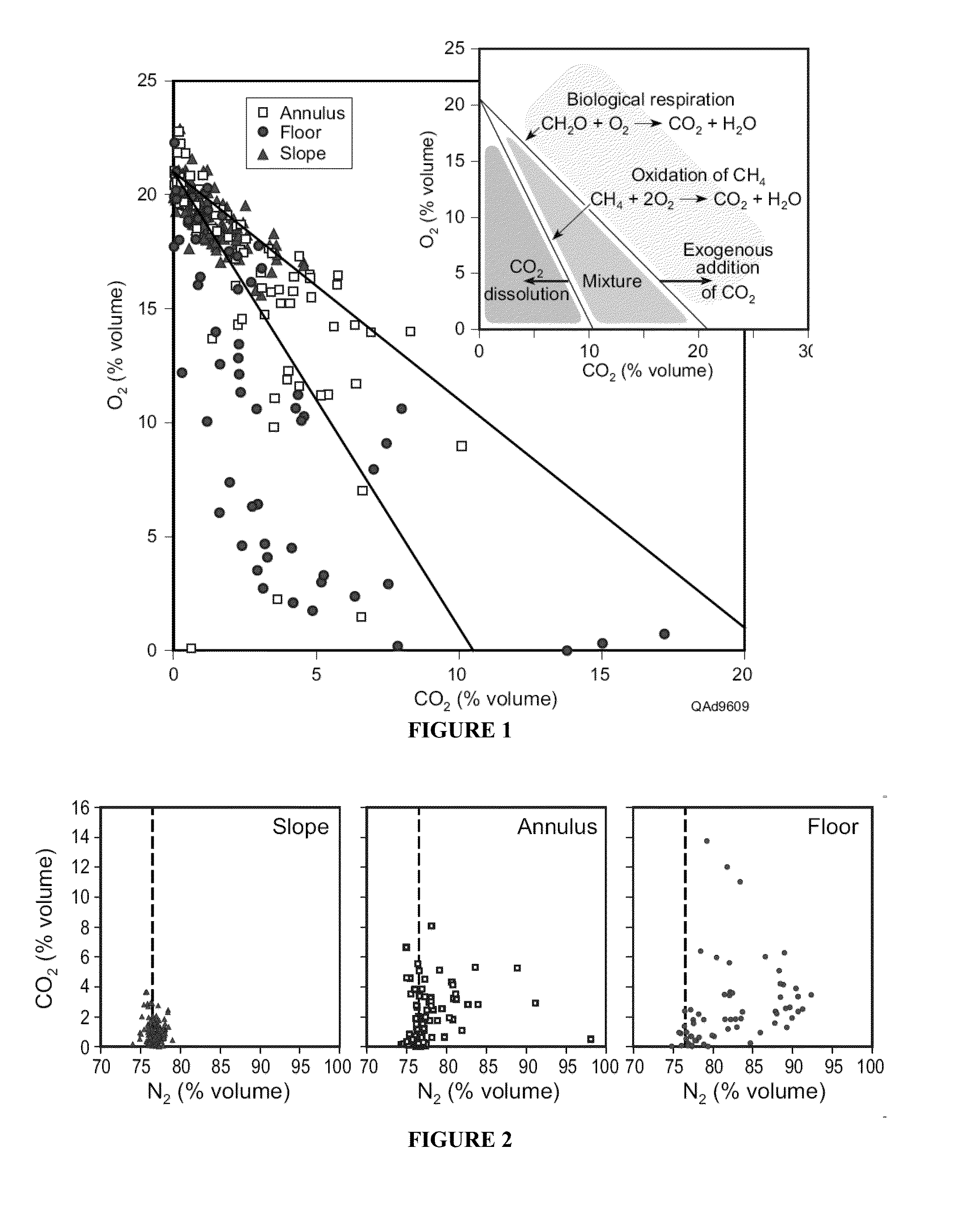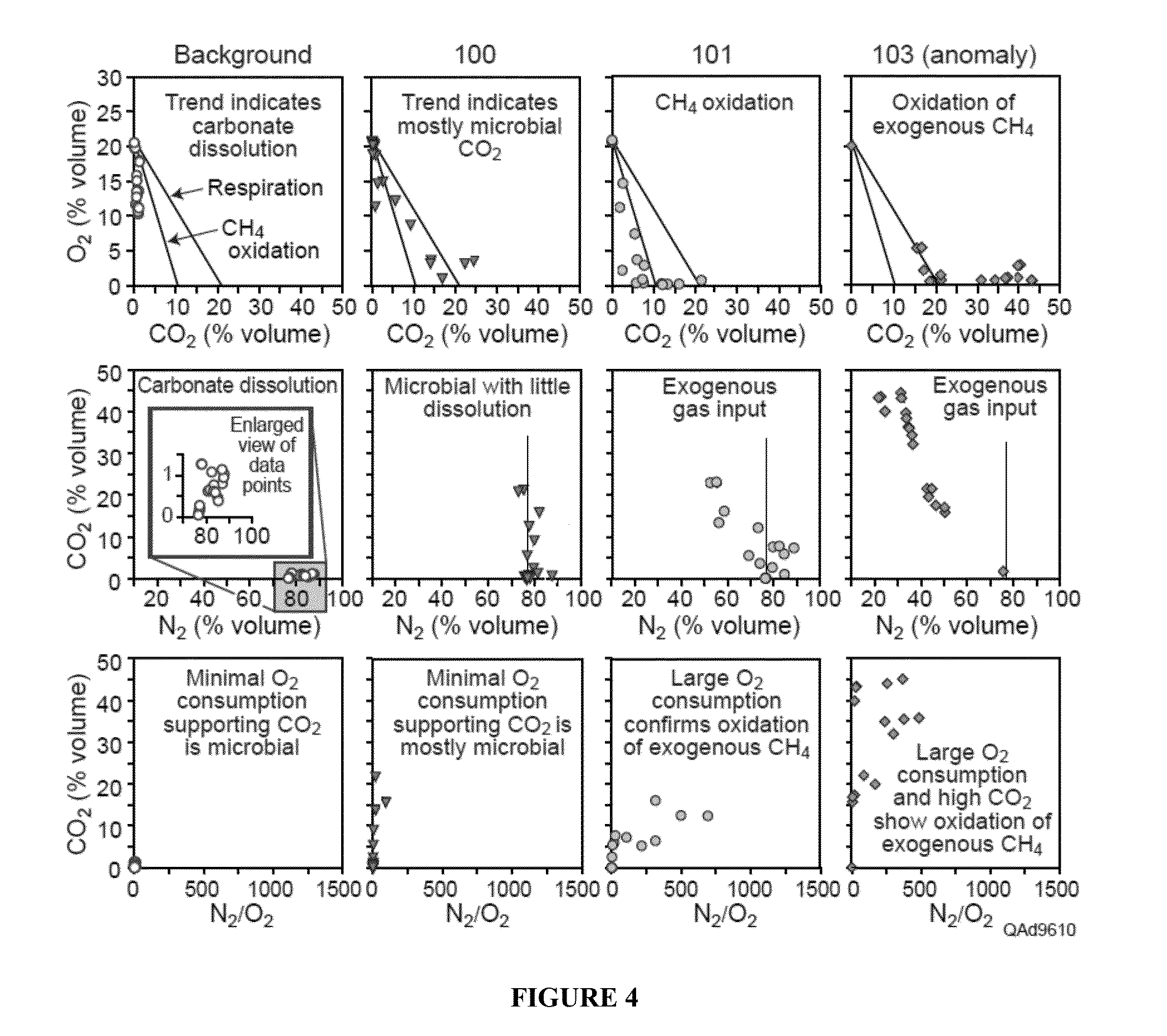Process-based approach for the detection of co2 injectate leakage
- Summary
- Abstract
- Description
- Claims
- Application Information
AI Technical Summary
Benefits of technology
Problems solved by technology
Method used
Image
Examples
example 1
Novel Process-Based Leakage Detection
[0046]Study sites. The process-based leakage detection approach was developed at a natural CO2-rich ephemeral playa lake in west Texas, USA. Here, known vadose zone processes were coupled with their corresponding soil gas signatures. This information was then successfully applied at an oil field in Mississippi at the site of a plugged and abandoned well to identify anomalous near-surface CO2 and CH4 soil gas signals.
[0047]Playa Natural Analog. The playa lakes of west Texas are broad, gently sloping circular basins (˜1 to 2 km in diameter) that accumulate and transmit surface runoff through a thick (˜60 m) vadose zone. Geomorphic areas associated with playas, which include: slope, annulus, and floor, systematically differ in water flux, organic carbon content, and inorganic soil carbonate, creating spatial variability in the main factors that affect natural vadose zone CO2 production and consumption [Osterkamp and Wood, 1987; Romanak, 1997]. These...
example 2
Detection of Injectate Leakage from an Injected Reservoir
[0065]As shown in the insert of FIG. 1, the O2 vs. CO2 ratio gives an indication of the main natural processes affecting CO2 concentrations. It provides a preliminary distinction among respiration and CH4 oxidation (black lines and middle portion between the two lines, labelled mixture) or dissolution (bottom left area between the axis and the first line, labelled CO2 dissolution). It also gives an initial assessment of leakage (top right quadrant).[0066]1. Measure CO2 O2 CH4 N2 (and H2O vapor if possible).[0067]2. On a gas chromatograph, the O2 reading actually includes Ar. So is actually O2 and Ar. These gases are not separated.[0068]3. Calculate Argon (Ar) as equal to 1 / 63×N2 concentration.[0069]4. Subtract Ar from O2.[0070]5. Add water vapor content or assume saturated at 2.3%.[0071]6. Normalize to 1 atm total pressure or 100%.[0072]7. Observe relationships between O2 versus CO2 with respect to the processes of respiration...
examples 1 and 2
[0135]European Commission (2009), Directive 2009 / 31 / EC of the European Parliament and of the Council of 23 Apr. 2009 on the geological storage of carbon dioxide: Official Journal of the European Union L 140 / 114 EN.[0136]Fryar, A. E., S. A. Macko, W. F. Mullican, K. D. Romanak, and P. C. Bennett (2000), Nitrate reduction during ground-water recharge, Southern High Plains, Tex.: Journal of Contaminant Hydrology 40, 335-363.[0137]Furche, M., S. Schlömer, E. Faber, and I. Dumke (2010), One year continuous vadose zone gas monitoring above an EGR test site Geophysical Research Abstracts Vol. 12, EGU2010-3095-1, 2010 7th EGU General Assembly 2010.[0138]Gustayson, T. C., and D. A. Winkler (1988), Depositional facies of the Miocene-Pliocene Ogallala Formation, northwestern Texas and eastern New Mexico: Geology, 16(3): 203-206.[0139]Hanson, P. J., N. T. Edwards, C. T. Garten, and J. A. Andrews (2000), Separating root and soil microbial contributions to soil respiration: A review of methods an...
PUM
| Property | Measurement | Unit |
|---|---|---|
| depth | aaaaa | aaaaa |
| depth | aaaaa | aaaaa |
| depth | aaaaa | aaaaa |
Abstract
Description
Claims
Application Information
 Login to View More
Login to View More - R&D
- Intellectual Property
- Life Sciences
- Materials
- Tech Scout
- Unparalleled Data Quality
- Higher Quality Content
- 60% Fewer Hallucinations
Browse by: Latest US Patents, China's latest patents, Technical Efficacy Thesaurus, Application Domain, Technology Topic, Popular Technical Reports.
© 2025 PatSnap. All rights reserved.Legal|Privacy policy|Modern Slavery Act Transparency Statement|Sitemap|About US| Contact US: help@patsnap.com



